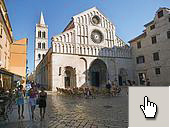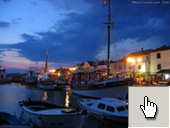 |
CENTRE OF THE ZADAR COUNTY
|
 The settlements in the Zadar County were founded in an area suitable for human life, in the central region of the Croatian coast. The county is surrounded by numerous islands, rivers, protected ports with a rich interior and exceptionally favorable climate. It has often been attacked and destroyed by numerous armies, and always rebuilt. The settlements in the Zadar County were founded in an area suitable for human life, in the central region of the Croatian coast. The county is surrounded by numerous islands, rivers, protected ports with a rich interior and exceptionally favorable climate. It has often been attacked and destroyed by numerous armies, and always rebuilt.
Zadar has been living a settlement type of life for over three millenniums. The first written account was recorded in the 4th ct. and material traces in the 9th century B.C. The first inhabitants was the Liburna tribe, while the city received it character when it was conquered by the Romans. At the start of the 7th century, Zadar became the main city in Dalmatia and remained so until 1918.
Besides Zadar as a county centre and the most important historical attraction, worth mentioning within the county is also Nin, the oldest Croatian royal city and the nation’s birthplace, as well as the seat for bishops. We should also mention Biograd, once a royal town, and the town of Pag, which was, founded according to Juraj the Dalmatian’s project and therefore included the small town amongst the monuments of urbanism.
|
THE CITY OF ZADAR
|
According to its cultural heritage, Zadar falls amongst the most interesting of the Croatian cities. The cultural attractions of the city of Zadar include:
- The church of St. Donat from the 9th century – unique in Europe,
- Forum from the 1st century from the era of Cesar Augustus – the largest researched forum on the eastern seaboard of the Adriatic,
- The monastery of St. Francis with a treasury and the oldest gothic church in Dalmatia,
- The cathedral of St. Anastasia dating from the 13th century and one of the nicest examples of Roman Age in Croatia with a floor mosaic from the 5th century,
- The church of St. Krizogon from the 12th century and one of the nicest examples of the Roman Age in Croatia,
- The bell tower of St. Mary from 1105, a nice example of the Roman Age, built by the Croatian-Hungarian king Koloman,
- The small church of St. Peter and Andrew the Elder from 5-6th centuries,
- The sarcophagus of St. Simeon with the consecrated body – a valuable example of Middle Age goldsmiths in Croatia,
- The foundations with the Renaissance main doors from the 16th century,
- Sea Gate with the in-built Roman arch,
- Permanent exhibition of sacral art with most impressive sacral objects in the form of relics and paintings from Zadar churches and the surrounding areas.
|
THE TOWN OF BIOGRAD
|
 Recognized as a Croatian town from the period 10th to 12th century when the first Hungarian-Croatian King Koloman was crowned. Recognized as a Croatian town from the period 10th to 12th century when the first Hungarian-Croatian King Koloman was crowned.
Today, Biograd is a typical tourist town which thanks to its excellent position in the middle of the Pašman canal, has developed into a significant nautical destination and cross-roads for sailors throughout Europe.
Besides the above mentioned attractive local attractions, guests are offered a unique opportunity by car, one-day excursion along the coast, to visit the old Dalmatian cities abundant with historical and cultural monuments such as: Šibenik (55km) from the famous Cathedral of St. James from the 15th century, Trogir (115km) a museum town known as “Little Venice” with more than 2800 years of history and life on the small island linked by a bridge to the mainland. Trogir is a monumental town under the protection of UNESCO. The city of Split (130km) is a monument to a cultural heritage with a preserved palace belonging to the Roman Emperor Diocletian and built as a villa before the 17th century, including a series of other attractions.
Guests – the faithful with religious needs, especially Catholics, have at their disposal a series of sacral objects almost in every place, the closest being a chapel 400m from the destination. |
NATIONAL PARKS
|
The St. Peter location where the stated vacation house is situated is surrounded by 5 national parks:
- Plitvička lakes (140km)
- Krka Waterfalls (60km)
- Paklenica (60km)
- Northern Velebit (150km)
- Kornati Islands – reached by boat trip in one or two hours.
|
NATURAL PARKS
|
Telašćica (cove on Dugi Island)
Vrana lake (10km) – the largest natural lake in Croatia, an important ornithological area in Europe inhabited, permanently and temporarily by about 224 species of birds.
The lake is rich in freshwater fish of which biological importance for the Mediterranean is the sub-species “roach”.
Velebit – mountain proclaimed by UNESCO a world biosphere reserve.
Visits to national parks, nature parks and other attractive locations remain imprinted in the visitor’s memory.
|
|
 |